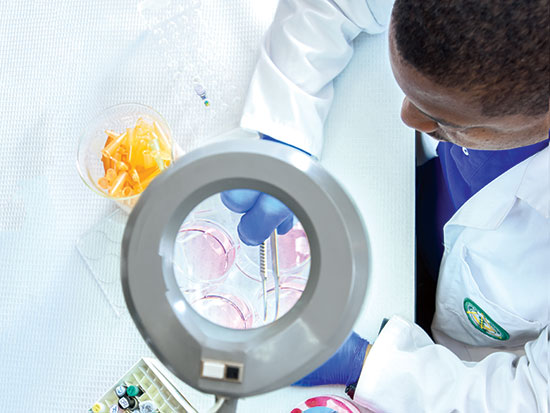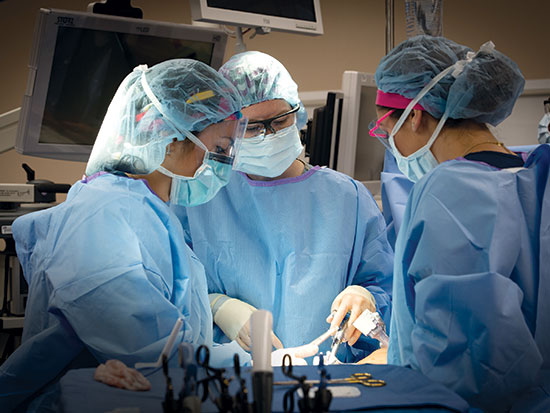 During the fall 2023 semester, UAB students, faculty and staff will have the opportunity to provide feedback and influence UAB’s next strategic plan — Forging Ahead — which will guide continued, purposeful growth for 2024-2028.
During the fall 2023 semester, UAB students, faculty and staff will have the opportunity to provide feedback and influence UAB’s next strategic plan — Forging Ahead — which will guide continued, purposeful growth for 2024-2028.
As we look ahead, we revisit the success achieved together through Forging the Future, UAB’s current strategic plan. Here, we celebrate our shared results and positive momentum in the Research pillar of our mission and the 2018-2023 strategic plan.
Research objectives outlined in Forging the Future were to enhance UAB’s institutional culture of collaboration and innovation, drive research and innovation across the enterprise, implement a campuswide effort to select and meet grand challenges, and improve society through processes and products.
Funding drives innovation, innovation drives funding
Over the past 10 years, UAB’s research funding has risen by 89 percent, from $379 million in fiscal year 2013 to $715 million in fiscal year 2022. That puts the institution in the top 1 percent of all public, private and international organizations funded by the National Institutes of Health. And UAB’s funding from industry has more than doubled in the life of Forging the Future.
But the real story, says UAB President Ray Watts, is not the money — it is the impact.
“The goal is not just to have more research dollars, but to have more research accomplishments that we know will positively impact the lives of many people,” he said.
UAB has created an increasing number of comprehensive centers and institutes in recent years, combining cutting-edge research, education and training that leads directly to breakthroughs that impact patient care in the areas of greatest need.
 On Jan. 20, 2022, Jayme Locke, M.D., director of the Comprehensive Transplant Institute, and her team reported the first transplant of genetically modified pig kidneys inside the abdomen of a person experiencing brain death. This is a potentially monumental step forward for the future of kidney transplantation and a major milestone for xenotransplantation, Locke says.
On Jan. 20, 2022, Jayme Locke, M.D., director of the Comprehensive Transplant Institute, and her team reported the first transplant of genetically modified pig kidneys inside the abdomen of a person experiencing brain death. This is a potentially monumental step forward for the future of kidney transplantation and a major milestone for xenotransplantation, Locke says.
Parallel with UAB’s dramatic rise in research funding over the past 10 years has been its success in commercializing that research. In 2022 alone, UAB’s Bill L. Harbert Institute for Innovation and Entrepreneurship, or HIIE, had $5.6 million in revenue, 106 intellectual property disclosures, 39 licenses and eight patents.
UAB faculty, students and staff have proved to have no trouble generating viable business opportunities with their ideas, either. In 2021, the Birmingham-based venture capital firm First Avenue Ventures launched a multimillion-dollar life science fund with a focus on early-stage drugs, therapies and devices developed at UAB and in Birmingham. The fund and the HIIE coordinate to drive momentum in the city’s emerging life-science ecosystem.
The first investment for First Avenue Ventures was ResBiotic, founded by physician scientist Charitharth Vivek Lal, M.D., an associate professor in the UAB Division of Neonatology. The investment will support ResBiotic’s commercialization of probiotics to cure chronic lung disease.
The fund “offers a critical resource for early-stage companies in the UAB pipeline,” said Kathy Nugent, Ph.D., executive director of the HIIE and chair of Clinical and Diagnostic Sciences in the School of Health Professions. “Having these resources focused on early-stage life science will help bridge the gap for companies spinning out of the lab.”
In 2021, the UAB spinoff company In8Bio (originally Incysus), a clinical stage biopharmaceutical company focused on discovery, development and commercialization of novel anti-cancer therapies, filed an initial public offering that raised $44 million.
Many more such promising startups are launching from UAB research. As of November 2022, nine companies were recently approved and poised to launch, with three more in the approval process.
“It’s exciting to see research born in the university spin out and grow in Birmingham, as our ecosystem is poised for cultivating innovative concepts,” Nugent said.
Clinical trials play a critical role in UAB research growth. Since 2013, UAB clinical trials expenditures have more than tripled, and there are more opportunities to take part in these potentially lifesaving studies at UAB than ever before.
In 2018, UAB’s Clinical Trials Administration Committee was created at the direction of UAB President Ray Watts. “CTAC draws people from each school, both investigators and administrators,” said Robert Kimberly, M.D., senior associate dean for Clinical and Translational Research in the Heersink School of Medicine and director of the UAB Center for Clinical and Translational Science. “The goal is to identify areas where we need to focus attention, such as new processes or policies from the NIH and other funders, or sources of inefficiency internally. When we do see a speed bump, the committee develops detailed action points to solve the problem.”
 It is important that the CTAC “was created from the president’s cabinet, with the president’s signature,” Kimberly said. “That demonstrated to everyone — from investigators to patients — that this is an institutional commitment.”
It is important that the CTAC “was created from the president’s cabinet, with the president’s signature,” Kimberly said. “That demonstrated to everyone — from investigators to patients — that this is an institutional commitment.”
Innovation infrastructure
Infrastructure is critical to research growth, and — guided by Forging the Future and UAB’s Campus Master Plan, UAB continues to invest in buildings and technology to speed innovation and discovery.
New and renovated facilities are drastically increasing UAB’s research capabilities. During the life of Forging the Future, UAB was moved forward with a new Science and Engineering Complex and the Altec Styslinger Genomic Medicine and Data Sciences Center, and recently announced a new Biomedical Research and Psychology Building that received $152 million in federal funding. Other key renovations include those to modernize UAB’s McCallum Basic Health Sciences Building renovation, the School of Dentistry building and Volker Hall.
In 2021, the university’s high-performance computing cluster, Cheaha — which become the state’s fastest supercomputer in 2016 — moved to UAB’s new $26.5 million Technology Innovation Center, powered by a cost-efficient Tesla Powerpack battery system to increase system reliability and decrease UAB’s carbon footprint. In fiscal year 2021 alone, Cheaha supported more than $213 million in research expenditures. More than 1,700 users are registered for research computing services, a nearly fivefold increase in the past five years.
Meeting a Grand Challenge
Forging the Future also established funding and a process to establish and launch a transformative initiative to address a significant problem that results from complex causes. The UAB Grand Challenge inspired 77 initial entries from teams across campus and the community. Following workshops, teams formed to further develop and consolidate their concepts, eventually producing six fully formed finalist proposals.
Out of the competitive process, the winning proposal was Healthy Alabama 2030 – Live HealthSmart, led by Professor Mona Fouad, M.D., a nationally recognized leader in health disparities research. Healthy Alabama 2030 aims to dramatically improve the health of all Alabamians and elevate the state out of the bottom 10 in national health rankings by the year 2030.
“Whatever ranking you choose — heart disease, obesity, diabetes, stroke — we are 49th or 48th. We want to change this position,” Fouad said at the time.
Live HealthSmart has partnered to transform neighborhoods by tackling policies, systems and infrastructure, from mobile stores to sidewalks, to streetlights, that promote wellness, education and economic opportunities.
The project received an initial three-year, $2.7 million award from the university. Since its inception, UAB has dedicated at least $5 million to the effort and has received significant third-party support. More than 100 corporate and community partners now work with UAB in Kingston, Titusville, East Lake, Bush Hills and north Birmingham neighborhoods, and support is increasing as efforts expand across Alabama.
See growth recaps of the Community Engagement, Patient Care and Education pillars and learn more about Forging the Future successes in Research and across all UAB mission pillars in UAB Magazine.
